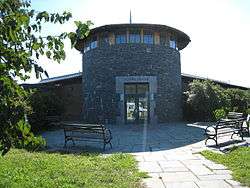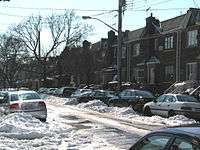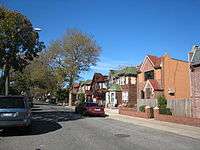Marine Park


Marine Park is the name of a neighborhood and the largest public park in the New York City borough of Brooklyn,[1] that lies between Flatlands and Mill Basin to the east, and Gerritsen Beach, Midwood, and Sheepshead Bay to the south and west. The neighborhood is mostly squared off in area by Gerritsen Avenue, Flatbush Avenue, Avenue U and Kings Highway. The eponymous park is within the neighborhood. The neighborhood is largely made up of ethnic groups such as Italians, Irish, Greeks, and Jews. The area is part of Brooklyn Community Board 18.[2] Charles Downing Lay won a silver medal in town planning at the 1936 Olympics for the planning of Marine Park.[3]
History
The neighborhood is situated around Gerritsen Creek, the westernmost inlet of Jamaica Bay;[4] the creek's path within the neighborhood was covered in 1920.[5][6] During the last 5,000 years, strips of sand were deposited by ocean currents. These beach strips form a surf-barrier and allow salt marshes to thrive:
...Gerritsen Creek was a freshwater stream that once extended about twice as far inland as it does today. Around 1920 the creek north of Avenue U was converted into an underground storm drain. Yet it continues to supply the salt marsh with fresh water, which helps the marsh support a wide range of organisms. ...[7]
The area was a hunting and fishing ground for Native Americans from the nearby village of Keshawchqueren. Pits for cooking and preparing food dating from 800 to 1400 AD were uncovered in Marine Park, along with deer and turtle bones, oyster shells, and sturgeon scales. In the 17th century, the Dutch began to settle in the area, which had similarities to the marshland and coastal plains of the Netherlands. The land proved to be fairly good farmland and there was an abundance of clams, oysters, and game from the region as well.
...Fearing that the relatively pristine marshland around Gerritsen Creek would be destroyed, Frederick B. Pratt and Alfred T. White offered the city 150 acres (0.6 km2) in the area for use as a park in 1917. After a seven-year delay the City accepted the offer. The prospect of a new park inspired developers to erect new homes in the area and, in the year 1926, form the organization, Marine Park Civic Association, although park improvements were slow to follow. Fill deposited in the marshlands in the 1930s and now land purchases increased the park's area to 1,822 acres (7 km2) by 1937. That year the Board of Aldermen named the site Brooklyn Marine Park...[7]
In the 18th century George Washington made a stop for several days on the land nearby. There was a gristmill on the water at the time; in 1938, the mill burned down to the water level, leaving only the low tide wood pilings across the water, which can be clearly seen to this day. In the mid-20th century the area was abused by trash and abandoned cars. At one point it became a landfill and trash piled up to 60 feet (18 m) in certain areas. After a massive cleanup effort in the 1990s the area was restored to its former glory, with exception of a few rusty car parts riddling the area, and teens littering and causing arson to the dry tall phragmite from time to time.
In the early 20th century, as industrialization swept the nation, developers made plans to turn Jamaica Bay into a port and prepared to dredge Rockaway channel to allow large ships into the proposed harbor. Speculators anticipated a real estate boom and bought land along the Jamaica Bay waterfront. However, donors turned the land over to the city with the stipulation that it be turned into a public park instead.
Demographics
In 2007, Marine Park had a population of 86,253. Marine Park is mostly made up of middle-class residents of various ethnic groups, including mostly Irish, then those of Italian and Greek heritage. The neighborhood celebrates many Irish Catholic traditional festivals.
Park


Marine Park is a public park located in the neighborhood of Marine Park. Its 530 acres (2.1 km2) of grassland and salt marsh surround the westernmost inlet of Jamaica Bay.[1] Most of the park's land was donated to New York City to be turned into public park land by the Whitney family in 1920 and by Frederic B. Pratt and Alfred Tredway White, who jointly donated 150 acres (0.61 km2) in 1917. The land donated consists of the area between the current day Fillmore Avenue and Gerritsen Avenue and East 38th Street. Originally almost two thousand acres (8 km2), over half of which has been donated to the National Park Service as part of the Gateway National Recreation Area, the park is mainly a fertile salt marsh which is supplied with freshwater from Gerritsen Creek. Marine Park, surrounded by the neighborhood it is named after, consists of recreational park areas and the Salt Marsh Nature Center, where myrtle warblers, grasshopper sparrows, cottontail rabbits, ring-necked pheasants, horseshoe crabs, and oyster toadfish can be found.
The park used to be a fishing ground for the village of Keshawchqueren. With new land purchases in the 1930s, the park grew to 1822 acres (7.4 km2) by 1937. That same year, the Board of Aldermen named the site "Brooklyn Marine Park".
The park gained its land mass as a dump, a dynamic that led to so many rats in the area that local children hunted them with bows and arrows in the 1960s.[8] One neighborhood boy was even bitten by a rat in his sleep.[8]
Recreational facilities were built in the decades to follow, including the Pratt-White athletic field (1939) that was dedicated to the two fathers of Marine Park. A 210-acre (0.85 km2) golf course opened in 1963, and the John V. Lindsay Model Airport was dedicated in 1971. The golf course was designed by renowned course architect Robert Trent Jones and hosts several pro-am golf tournaments, including the Brooklyn Open and the Jamaica Open NY Golf Tournament. New ballfields were opened in 1979 and named for baseball-loving NYPD Officer Rocco Torre in 1997. Nature trails established along Gerritsen Creek in 1984-85 invite parkgoers to observe a wealth of flora and fauna. Ongoing improvements at the end of the 20th century include the reconstruction of basketball, tennis, and bocce courts; of baseball fields; and of Lenape Playground at Avenue U. A new nature center opened in 2000. The Carmine Carro Community Center, named for Carmine Carro, a local activist and park advocate who served as president for the Marine Park Civic Association, opened in March 2013.[9] The building's “green” elements include solar panels, a geothermal heating and cooling system, and a green roof. Because of these energy-saving features, the Parks Department is seeking LEED Silver certification for the building.[10] The park's playground, several sports fields, and 0.83 mile-long running path were all built on the ancient Keshawchqueren burial ground.[11]
Image gallery
 Brick row houses on Gerritsen Avenue
Brick row houses on Gerritsen Avenue- Old building
 Porch on a row house
Porch on a row house Row houses in winter
Row houses in winter Row houses in fall
Row houses in fall- The Hendrick I. Lott House, in the neighborhood
See also
References
- 1 2 Marine Park, New York City Department of Parks and Recreation. Accessed September 24, 2016. "As Brooklyn's largest park, Marine Park has plenty of room to serve a lot of needs. Environmentally, it consists of 530 acres of grassland and precious salt marsh, protected as a Forever Wild preserve."
- ↑ "Brooklyn Community Boards". City of New York. Retrieved March 17, 2014.
- ↑ "And the Medal Goes to...". Brooklyn Public Library. Retrieved August 12, 2016.
- ↑ "Officials Celebrate the Gerritsen Creek Ecosystem Restoration Project in Marine Park". US Army Corps of Engineers. 2012-08-14. Archived from the original on 2013-02-25. Retrieved 2014-08-07.
“Gerritsen Creek is one of the original “fingers” of the great “hand” of Jamaica Bay, and over the last century it has been the victim of human intrusions that have damaged its ecological functioning,” said Parks Commissioner Benepe.
- ↑ Josephine Axt (2003). "Ecosystem restoration promotes understanding" (PDF). US Army Corps of Engineers. Archived from the original on 2013-02-25. Retrieved 2014-08-07.
The more recent research showed the various stages of the modern history of Gerritsen’s Creek, including how it used to extend approximately eight blocks further north than its current ending point at Avenue U in Brooklyn, N.Y.
- ↑ "FACT SHEET-Gerritsen Creek–MARINE PARK, NY: Ecosystem Restoration Project". US Army Corps of Engineers. Archived from the original on 2013-02-18. Retrieved 2014-08-07.
- 1 2 Marine Park Civic Association. "The History of Marine Park". Archived from the original on November 18, 2013. Retrieved July 24, 2006.
- 1 2 Tolchin, Martin (6 April 1965). "Brooklyn's Marine Park Filled with Garbage, Rats and Junk". New York Times.
- ↑ "Marine Park's Long-Awaited Green Community Center Now Open!". March 4, 2013. Retrieved March 17, 2013.
- ↑ "Carmine Carro Community Center Opens In Marine Park (press release)". New York City Department of Parks and Recreation. Retrieved 4 May 2014.
- ↑ Wall, Diana diZerega (2004). Touring Gotham's Archaeological Past: 8 Self-Guided Walking Tours through New York City. Yale University. pp. 173–175. ISBN 0300103883.
External links
| Wikimedia Commons has media related to Marine Park, Brooklyn. |
Coordinates: 40°35′53″N 73°55′15″W / 40.59804°N 73.92083°W
